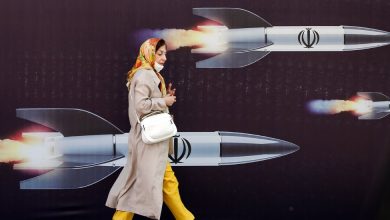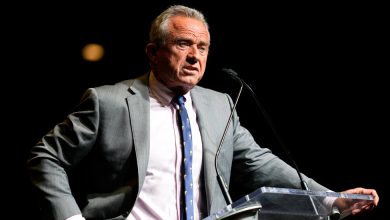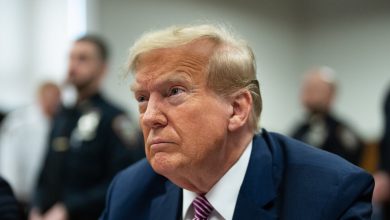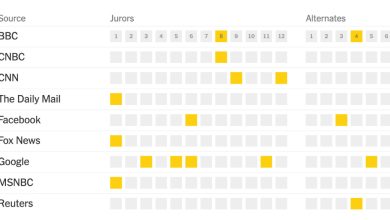As Police Hunt for Gunman, Fear Rattles Homeless People in 2 Cities

Anthony Pla, homeless since 2015 and a New Yorker for 35 years, said that until this weekend, he had never experienced anything as unsettling as the streets of the city emptying out during the pandemic.
“I survived that,” Mr. Pla, 58, said Monday as he stood outside Holy Apostles Soup Kitchen in Manhattan. “And now we have people killing each other.”
He spoke as the police and federal agents in New York and Washington fanned out in both cities in their search for a gunman who over the last two weeks shot five men who were sleeping in the streets, killing one in each city. One law enforcement official described the man as a serial killer.
In New York, investigators canvassed the street looking for video to help them identify the gunman and trace his steps. They searched encampments with outreach workers, looking for others he might have targeted, law enforcement officials said, distributing fliers with pictures of a suspect. And they searched block by block for people sleeping on the streets, encouraging them to move into shelters to prevent another killing.
Two hundred miles away in Washington, the mayors of both cities were preparing to give an update on the case on Monday evening. Many questions remain unanswered, including who the gunman is, how he traveled from Washington to New York and why he has targeted people living on the street, who expressed fear and anger in a series of interviews on Monday.
Authorities connected the cases after law enforcement officials in Washington reached out to officials in New York over the weekend following a Saturday night news conference about the two shootings, according to a senior police official. Ballistics analysis confirmed that the same gun had been used in the shootings, according to a federal law enforcement official.
In each of the shootings, which began March 3 in Washington, D.C., a lone gunman dressed in dark clothing targeted sleeping homeless men between midnight and dawn. The first killing was March 9 on New York Avenue Northeast in Washington, when a man was fatally shot and stabbed and his tent set on fire.
Three nights later, on Saturday, two men were shot in New York. The first, a 38-year-old, was sleeping near the entrance to the Holland Tunnel when he was struck in the arm. He was hospitalized in stable condition, the police said.
A short time later and less than a mile away, the second man was sleeping in a sleeping bag in the doorway of 148 Lafayette Street in SoHo. A surveillance camera recorded the gunman approaching and kicking him, then shooting him in the head and neck. The victim, who was not carrying identification, was discovered dead late in the afternoon.
He had been a fixture in his corner of SoHo for more than a decade and was known among the shopkeepers and street vendors as “Gambia,” after the West African country where he had been born. They remembered a handsome and polite man who had quietly scraped by on donations after an apparent mental breakdown.
Abou Diakite, a local street vendor, said he had given the man $2 just last week so that he could buy coffee. He clicked his tongue in despair at the loss.
The death of a third homeless man in Manhattan on Sunday evening is not believed to be linked to the gunman, but investigators have not reached a conclusion, a law enforcement official said on Monday.
The shootings come at an extraordinarily anxious moment for the thousands of people who live unsheltered in New York City and underscore the vulnerability of people sleeping outdoors. They also recalled other serial attacks against homeless people in the city, including a 2019 spree that left four homeless men dead in Chinatown and the February 2021 stabbings of four homeless people in and around the subway, two of whom died.
And they come several weeks into a campaign by Mayor Eric Adams to remove homeless people who shelter in the subway system. Advocates for homeless people had warned that the effort would push many people to the street who refuse to stay in the city’s barrackslike group shelters, which they find rife with crime and interpersonal conflict.
In interviews in both cities, several homeless people who live in the streets and transit systems said they were unnerved by the attacks, but not enough to move indoors.
“Listen, the streets are dangerous,” Marty Mercer, 51, said near his tent in the makeshift campground in front of Union Station in Washington Monday morning as commuters hurried by. “Just because someone is doing this on a serial basis is no different.”
Mr. Mercer, a former retirement planner from California, said that he and his friends have heard of at least two stabbings and a pepper-spray assault this winter. “We try to look out for each other,” he said.
In New York outside Holy Apostles on Ninth Avenue, Ossie Andrew, 42, said that he was jumped while sleeping on a subway train about a month ago but that he still considered living in the streets and trains safer than group shelters.
“Once it’s late at night, those are risks that you take,” Mr. Andrew said.
In New York, people living on the streets and subways have been a growing source of concern during the pandemic, both for their own well-being and for the well-being of some of the people they come in contact with.
A series of random attacks across the city, some of them fatal and committed by homeless people, according to the police, have led to homeless people being widely cast as a social menace that needs to be tamed.
Last month, Mr. Adams announced a wide-ranging plan to clear the subway of the people who live there. It includes sending more social workers and medical professionals into the transit system to offer services as well as more aggressive enforcement of rules against loitering and orders for the police to evict anyone using the subway for anything other than transportation.
At a vigil on Sunday for the two men shot in Manhattan, Carl Garrison, a minister of homeless outreach at the Manhattan Church of Christ, said the demonization of the homeless was in part responsible for the current attacks. “You can’t talk about people as being vermin and being ‘disgusting animals’ without it having a repercussion,” he said. “Last night was the repercussion of this.”
The city has scrambled for years to create more housing of the sort that would entice homeless people off the street. Mr. Adams’s predecessor, Bill de Blasio, opened several thousand beds in so-called low-threshold shelters that offer private rooms and fewer rules and curfews than traditional shelters. But those rooms remain in short supply. Meanwhile, the city has torn down more homeless encampments.
On Sunday, an advocacy group, the Safety Net Project of the Urban Justice Center, urged the city to suspend its encampment sweeps and house all unsheltered people in private rooms immediately. Officials did not immediately respond to a request for comment on the proposal.
In the wake of the 2019 killings of four homeless men who were sleeping on the street in Chinatown, the city said it would build more shelters in the area. Recently, it announced plans to open three private-room shelters in Chinatown.
But, in part because of an increase in anti-Asian attacks, the proposed shelters have been loudly opposed. Shelter opponents quickly raised over $100,000 for a planned lawsuit. Last month’s Lunar New Year parade featured sign-waving demonstrators urging Mr. Adams to “save Chinatown” by canceling the shelters.
One of the proposed sites, scheduled to open later this year on Grand Street, is just seven blocks from where the man sleeping in the doorway was killed on Saturday.
In Washington, the homeless population has been declining for years, as more resources have been made available to homeless families and veterans in particular. But as the city has become ever less affordable, the number of chronically homeless single adults has not declined, and, according to the 2021 survey of the homeless, even rose during the pandemic.
Given the fears of the Covid-19 era, several advocates for the homeless said, more people had been living outside rather than in communal shelters. Some came together for safety in small clusters in parking lots or construction sites, while others set up tents on sidewalks outside of the sleek office buildings and government agencies of downtown Washington.
The recent shootings only show how crucial it is to address homelessness through programs like housing vouchers and other investments, said Christy Respress, the executive director of Pathways to Housing DC, a nonprofit group.
“Something like this makes it so clear the real dangers that people are facing outside, whether it’s dying of the elements of being exposed to horrific violence,” she said.
At Triangle Park in Washington, where he pitched a camping tent among 15 others two months ago, Kenneth Kiser, 58, was rattled.
Mr. Kiser said he first heard of the shootings Monday morning when he went to a methadone clinic for treatment. Clinic workers urged him to seek shelter and assured him the city had available beds.
But Mr. Kiser was not interested, saying he had $10 and some personal items stolen the last time he stayed at a men’s shelter.
“I sleep with one eye open anyway,” he said. “I’m always afraid that my throat will be slit or I’ll be robbed. So I’m careful.”
Sean Piccoli and Samira Sadeque contributed reporting from New York. JoAnna Daemmrich and Glenn Thrush contributed reporting from Washington, D.C. Campbell Robertson contributed reporting from Pittsburgh.




